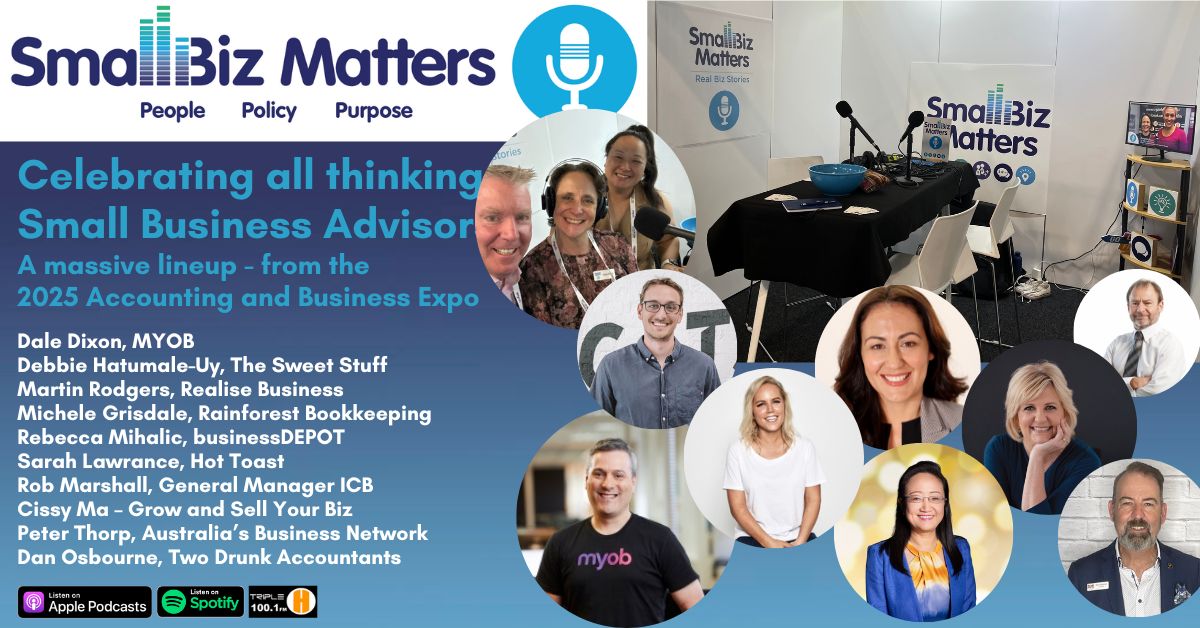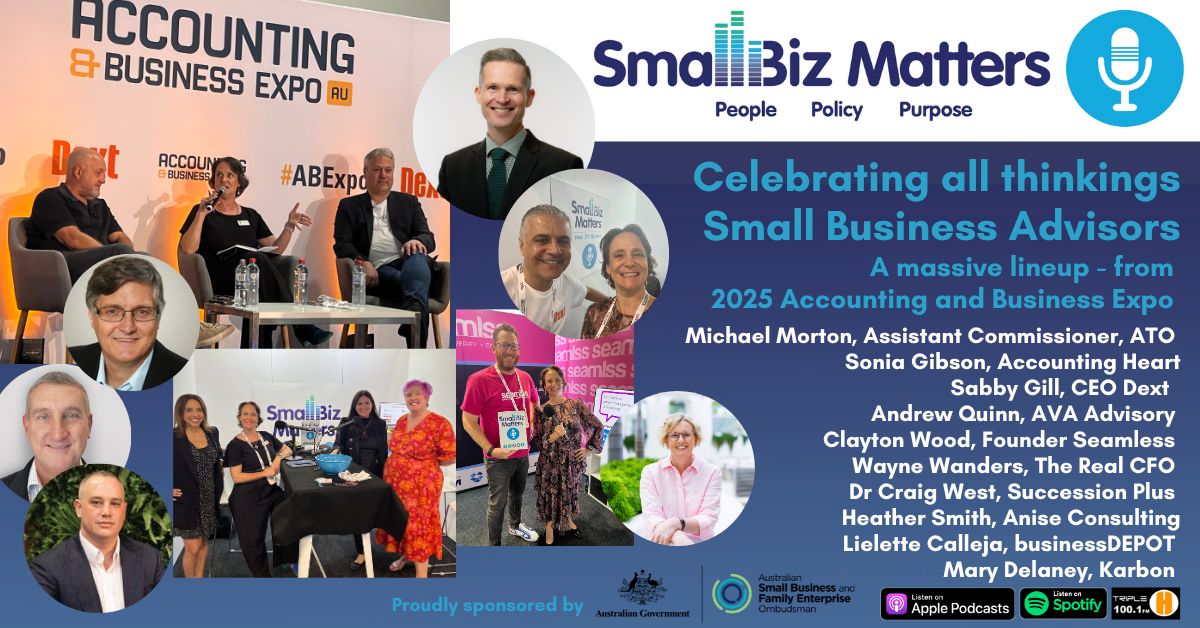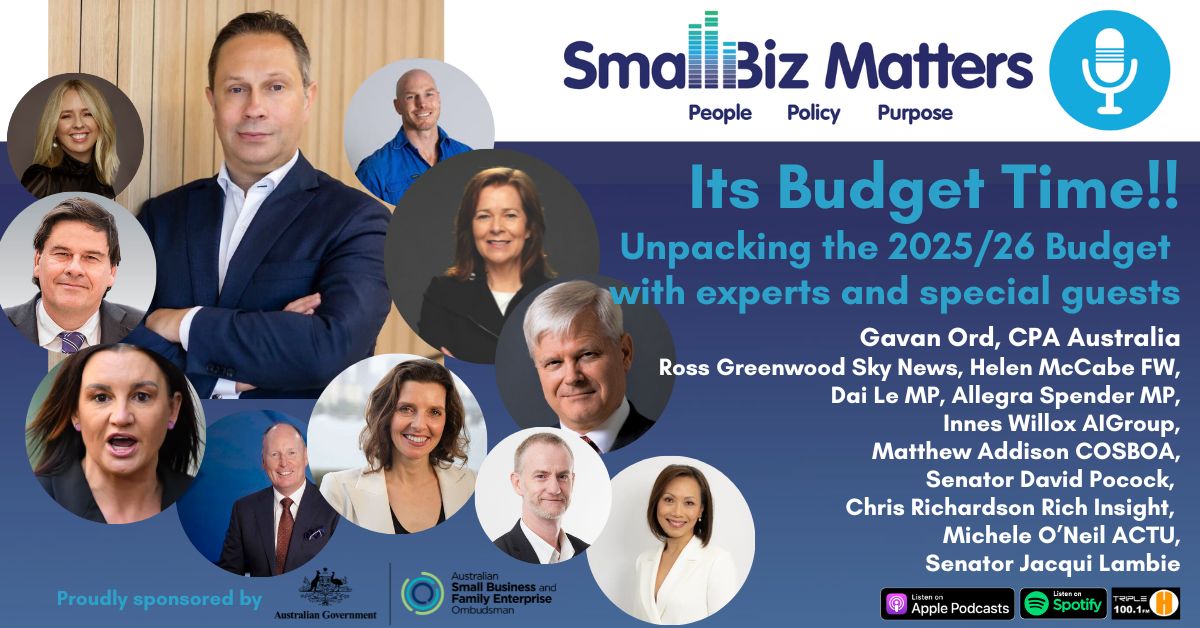Why A Simple Bucket Can Revolutionise Your Thinking About Your Business
| Thursday January 17Small Biz Matters – a half hour program each week where you can work ON your business rather than IN it.
with Alexi Boyd from Boyd Office Management Services
Date: 15 January 2019
We always talk on Small Biz Matters about the importance of surrounding our small businesses with good people and finance is a MUST when it comes to finding the right fit. We’re all familiar with bookkeepers and accountants but there’s a new kid in town. Chief Financial Officers were previously the domain of large corporates but with the move towards a more flexible lifestyle rather than J.O.B.s we have more of these highly experienced and financially knowledgeable experts in our midst. And many of them really want to bring to small business this incredible knowledge.
Now, you may think what can a CFO of an enormous company teach me and my micro or small business? Well, as Wayne Wanders is about to teach us, the concepts are very similar and can be applied to the approach you have to your finances. You just need the right expert to show you how!
- Welcome to the show Wayne.
Thank You Alexi and it is great to be here on Small Biz Matters. I hope you and all your listeners had a great Christmas and new year
- Broadly outline your small business journey and what led you to start your own business from the life as a CFO?
I am and have been for over 30 years, a fully qualified chartered accountant and business advisor. In this time, I have been the CFO and company secretary of 2 businesses listed on the Australian Stock Exchange.
About 20 years ago I was the Australian CFO of a US company starting up in Australia. But it was a really frustrating place to work as I had bosses in Sydney, Hong Kong, London and the US. And it was too hard to get things changed.
In the end I decided that life was too short to waste my time trying to help people who would not listen and it was then that I realised that I only wanted to work directly with people who could make decisions.
And in Australia, these people are the business owners and CEO’s of small and medium businesses.
But few of these businesses could afford to employ someone like me on a full basis. So that’s when I set up my own outsourced CFO business, offering my talents, strengths, skills and experience on a part time basis, for a fraction of the cost of a full time employee.
And I have been doing this now for nearly 20 years helping small and medium business owners as they grow their business.
- Why, when all other financial experts focus on the traditional P&L do you suggest that its “utterly useless to manage your business”?
The traditional profit and loss most business get from their book keeper or accountant are great to prepare your tax return but as you said, I believe they are utterly useless for a business owner to help them manage their business.
And the easiest way to explain this is to give you an example from some northern suburbs business owners I was talking to just last week.
They are a husband and wife team who run a digital marketing company. They have several service offerings such as design, building websites, SEO, social media marketing etc.
When I asked about how they delivered this they mentioned they use a combination of their own staff and contractors.
Now we started talking about how they could grow their business and make more money.
My comment was that for most businesses, about 20% of the business generates about 80% of the profit. And if you want to grow your business and make more money, you want to grow the bit that is making the most money.
So I had a look at their financial reports to see if I could see where they are making their money.
And guess what, their financial reports were done in the traditional manner with revenue and expenses just detailed in alphabetical order.
Here were some of the problems I saw immediately.
- Most of their revenue was in one account called “projects”. They could not tell me how much revenue was from each of their core service offerings.
- Contractor costs were correctly in cost of sales, but was not split between their core service offerings.
- All staff costs were in one account. There was no breakdown between work on projects, and which service offering these related to, and overhead / admin costs.
They had no way of knowing how much money each of their service offerings were making. And more importantly they had no idea which service offering was making the most money.
And if they went ahead and started to try and grow their business, there was a strong chance that they would have more revenue, more hassles but no more profit.
Putting it simplistically, about the only thing the traditional profit and loss they had was good for, was to work out their taxable income. So great for the tax man but useless to help them manage their business.
And this is just the most recent example I have seen. I can add plenty more to this and this is why I say, controversially for an accountant, that for many business owners they might as well throw their traditional profit and loss in the bin.
- What should we replace it with?
The simplest way to replace your traditional profit and loss is to stop thinking in alphabetical order but start thinking in business activities.
And to start thinking of activities, the simplest way is to start putting your profit and loss items in different activity buckets.
Now these buckets will be different for each business, but let’s have a look at what I would recommend for the digital marketing company I have been talking about.
I would have the business owners create a bucket for each of their core service offerings, a bucket for miscellaneous services and one for overhead. In this case about six buckets for the business.
I would then make sure all revenue and costs were recorded in the right bucket. In effect each bucket has its own mini profit and loss.
So, the first benefit for business owners of using the bucket concept is that they now can understand what business activity (bucket) makes the most money. And the business owner can make informed decisions about which business activity they want to grow, and possibly what business activities they want to stop offering.
- Does the bucket system help businesses grow?
Yes, the bucket system does help business owners grow profitably.
Now the key to successfully growing a business is that the money, time and effort you spend to acquire a new customer, is less than the money you make from that customer.
This is Business 101, but time and time again, I see businesses spend $100 to get a customer worth $80. All these business owners do, is effectively grow broke.
To help the business owner to grow profitably (instead of growing broke), we take some of the buckets to a deeper level.
Let’s use the digital marketing company I have been talking about and let’s say managing a client’s social media is the business activity they want to grow.
So, for this bucket, I would recommend that they create sub buckets matching key business activities in this situation. These are getting the customer (customer acquisition costs), and the monthly social media management (direct cost of sales).
Now every cost in the social media bucket needs to be split between customer acquisition and direct cost of sales.
Once we have these costs in the sub buckets, we can start to calculate some Key Performance Indicators (KPIs) to see if the business is actually growing profitably.
The first KPI you want to work out is the acquisition cost per customer. You simply add up all the acquisition costs in the bucket for the month and divide by the number of new customers for the month. This tells you how much you are spending to get each new customer.
The second KPI you want to work out is the monthly contribution by customer. The monthly contribution is simply monthly revenue less direct cost of sales. And to get the monthly contribution by customer, simply divide by the total number of customers.
The third KPI is to understand how long you keep your customer. Is it for a month, six months, a year?
Once you know how long you keep a customer, you can work out 4th KPI, being the lifetime value of a customer. This is the monthly contribution per customer times the number of months on average, they remain a customer.
Now you can work out if you are profitably growing your business
If you have profitable growth, the lifetime value of your customer (the 4th KPI I just mentioned) is more than the acquisition cost per customer (the 1st KPI)
If the acquisition cost per customer is more than the lifetime value of the customer, you are not adding new business profitably. You are instead growing broke and you need to change your strategy..
- What can a business do if it is growing broke?
The beauty of the buckets system and working out the KPI’s like acquisition cost per customer and lifetime value per customer is that it lets the business owner see quickly of they are growing profitably or not.
If they are not growing profitably, they can start to take action before it is too late and the business runs out of cash.
Steps the business owner can take include any or all of:
- Spending less to acquire a customer.
- Increasing the contribution by customer. This could be more revenue by cross selling other services, and / or by reducing costs to deliver the service,
- Keeping the customer longer.
And more importantly, even if the business is growing profitably, the business owner can still take any of the actions above to improve their profitability.
And that is the real benefit to a business owner of implementing the bucket system and combining this with the appropriate KPIs.
Being able to make decisions, measure how effective these decisions were and changing as required to improve business performance. Your traditional profit and loss does not allow you to do this.
- So what is the key message you want to leave business owners with?
The key message I want to leave business owners with is if you want to make effective decisions that allow you to profitably grow your business, you need to start analysing and thinking about your business in buckets, aligned with the right key performance indicators.
Wayne’ Bio:
Wayne Wanders The Wealth Navigator, has been a fully qualified chartered accountant and business advisor for over 30 years. In this time, Wayne was the Chief Financial Officer (CFO) and company secretary of two businesses listed on the Australian Stock Exchange.
About 20 years ago Wayne was the Australian CFO of a USA company starting up in Australia. But it was a really frustrating place to work as Wayne had bosses in Sydney, Hong Kong, London and the US. And it was too hard to get things changed.
In the end Wayne decided that life was too short to waste his time trying to help people who would not listen and it was then that Wayne decided that he only wanted to work directly with people who could make decisions.
And in Australia, these people are the business owners and CEO’s of small and medium businesses.
But few of these businesses could afford to employ someone like Wayne on a full basis. So that’s when Wayne set up his own outsourced CFO business, offering his talents, strengths, skills and experience on a part time basis, for a fraction of the cost of a full-time employee.
And Wayne have been doing this now for nearly 20 years helping small and medium business owners successfully navigate through their financial challenges to profitably grow their business.
To find out more go to Wayne’s website: http://arealcfo.com.au/





